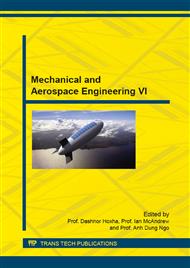p.261
p.266
p.271
p.276
p.282
p.287
p.292
p.297
p.303
Formation Control of Quadrotor UAVs by Vision-Based Positioning
Abstract:
In this paper, a formation control method of quadrotor Unmanned Aerial Vehicles (UAVs) by vision-based positioning is presented. The relative positions and attitudes of two UAVs with respect to a visual marker attached to the third UAV is estimated by a camera calibration method. Based on the estimated positions and attitudes, two UAVs are controlled to the desired positions to form a given formation with respect to the third UAV. A simplified dynamics model of a quadrotor UAV is utilized to design a controller. The proposed formation control method is validated by an experiment with a motion capture system which provides the ground truth of the position data.
Info:
Periodical:
Pages:
282-286
Citation:
Online since:
October 2015
Authors:
Keywords:
Price:
Сopyright:
© 2015 Trans Tech Publications Ltd. All Rights Reserved
Share:
Citation:


